
Hadronyche formidabilis, the northern tree-dwelling funnel-web spider, is a medically significant mygalomorph spider found in Queensland and New South Wales. It is also known as the Northern Rivers funnel-web spider or northern funnel-web spider.
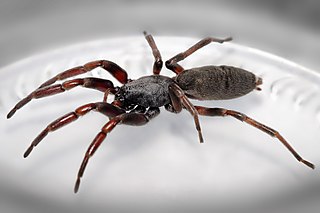
White-tailed spiders are spiders native to southern and eastern Australia, and so named because of the whitish tips at the end of their abdomens. The body size is up to 18 mm, with a leg-span of 28 mm. Common species are Lampona cylindrata and Lampona murina. Both these species have been introduced to New Zealand.

Phidippus audax is a common jumping spider of North America. It is commonly referred to as the daring jumping spider, or bold jumping spider. The spider belongs to the genus Phidippus, a group of jumping spiders easily identified both by their relatively large size and their iridescent chelicerae.

Abracadabrella is a genus of spiders in the family Salticidae whose spp. appear to mimics flies. The type species for the genus was described by Ludwig Koch (1879) as Marptusa elegans, transferred to Ocrisiona by Eugène Simon (1901) then placed into Abracadabrella by Marek Żabka (1991).
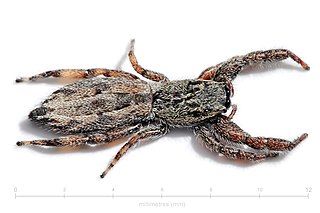
Holoplatys is a genus of the spider family Salticidae.
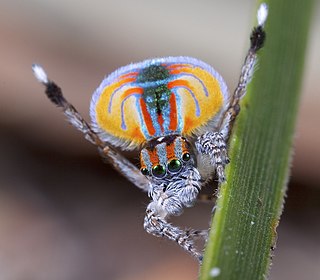
Maratus is a spider genus of the family Salticidae. These spiders are commonly referred to as peacock spiders due to the males' colorful and usually iridescent patterns on the upper surface of the abdomen often enhanced with lateral flaps or bristles, which they display during courtship. Females lack these bright colors, being cryptic in appearance. In at least one species, Maratus vespertilio, the expansion of the flaps also occurs during ritualised contests between males. The male display and courtship dance are complex, involving visual and vibratory signals.

Margaromma is a spider genus of the jumping spider family, Salticidae. The eight described species occur mostly in Australia and New Zealand, with several other species on Pacific islands. One species is found in Cameroon.

Zenodorus is a genus of the jumping spiders distributed from the Moluccas to Australia, including several islands of the Pacific. It was once considered a junior synonym of Omoedus, but this was later rejected by Jerzy Prószyński in 2017. At least one species, Z. orbiculatus, specializes on hunting ants.

Maratus volans is a species in the jumping spider family (Salticidae), belonging to the genus Maratus. These spiders are native to certain areas in Australia and occupy a wide distribution of habitats. They have a specialized visual system that allows them to see the full visible spectrum as well as in the UV-range; this helps them detect and pursue prey. Males of this species are characterized by their colorful abdomen flaps that are used to attract females during courtship.

Prostheclina pallida is a species of spider in the family Salticidae, native to Eastern Australia. It was described by Keyserling in 1882, and remained the only species in the genus until 2007, when six more species were described.

Maevia inclemens is a relatively common and colorful jumping spider of North America. In the males there are two forms, a very rare phenomenon in zoology. These use different courting displays, and differ in appearance: the "tufted" morph has a black body and pedipalps ("palps"), three black tufts across its "head", and pale legs; and the "gray" morph has black and white stripes all over its body and legs, orange palps, and no tufts. However, each form accounts for 50% of the adult males, and they are equally successful in mating. A female of Maevia inclemens is 6.5 to 8.0 millimetres long, while males are 4.75 to 6.50 millimetres long.

Australia has a number of highly venomous spiders, including the Sydney Funnel-web, its relatives in the family Hexathelidae, and the Redback Spider, whose bites can be extremely painful and have historically been linked with deaths in medical records. Most Australian spiders do not have venom that is considered to be dangerously toxic. No deaths caused by spider bites in Australia have been substantiated by a coronial inquest since 1979. There are sensationalised news reports regarding Australian spiders that fail to cite evidence. A Field Guide to Spiders of Australia published by CSIRO Publishing in 2017 featuring around 836 species illustrated with photographs of live animals, around 381 genera and 78 families, introduced significant updates to taxonomy from Ramirez, Wheeler and Dmitrov

Spiders are air-breathing arthropods that have eight legs, chelicerae with fangs generally able to inject venom, and spinnerets that extrude silk. They are the largest order of arachnids and rank seventh in total species diversity among all orders of organisms. Spiders are found worldwide on every continent except for Antarctica, and have become established in nearly every habitat with the exceptions of air and sea colonization. As of July 2019, at least 48,200 spider species, and 120 families have been recorded by taxonomists. However, there has been dissension within the scientific community as to how all these families should be classified, as evidenced by the over 20 different classifications that have been proposed since 1900.

Cyrtophora exanthematica are tent spiders common in tropical Asia and Australia. They are commonly known as double-tailed tent spiders because of the pair of blunt projections at the end of their abdomens. They are harmless to humans.
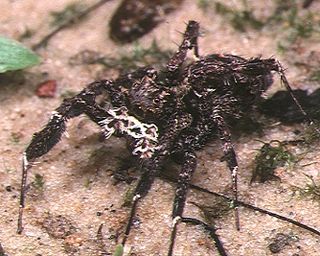
Portia fimbriata, sometimes called the fringed jumping spider, is a jumping spider found in Australia and Southeast Asia. Adult females have bodies 6.8 to 10.5 millimetres long, while those of adult males are 5.2 to 6.5 millimetres long. Both sexes have a generally dark brown carapace, reddish brown chelicerae ("fangs"), a brown underside, dark brown palps with white hairs, and dark brown abdomens with white spots on the upper side. Both sexes have fine, faint markings and soft fringes of hair, and the legs are spindly and fringed. However, specimens from New Guinea and Indonesia have orange-brown carapaces and yellowish abdomens. In all species of the genus Portia, the abdomen distends when the spider is well fed or producing eggs.

Hadronyche infensa, the Darling Downs funnel-web spider, is a venomous mygalomorph spider, one of a number of Australian funnel-web spiders found in Queensland and New South Wales.
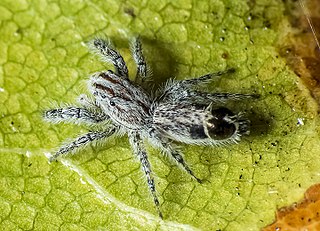
Abracadabrella elegans is a species of jumping spider in the genus Abracadabrella. Its common name is Elegant Fly Mimic. It is reasonably common in coastal Eastern Australia, mostly Queensland. It appears to mimic a large fly with two black raised, rounded mounds on the rear of the abdomen, which look like eyes, and its spinnerets which resemble a fly's mouthparts. It walks backwards apparently to enhance the mimicry. Abracadabrella spp. are found on or under bark or on foliage from coastal north Queensland south to at least the central coast NSW.
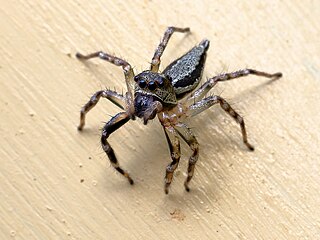
Zenodorus swiftorum is a species of ant-hunting jumping spider found in Papua New Guinea and northern Australia.The common name is Swifts' ant-hunter, and was named in honour of Kristin Swift and John Swift who supported Conservation International in New Guinea. Zenodorus swiftorum is common but variable across tropical Australia and countries to the north. Females are slightly larger than males.

Zenodorus orbiculatus, the round ant eater, is a species of ant-hunting jumping spider found in Australia. The species was first formally named by Eugen von Keyserling in 1881 as Hasarius orbiculatus.

Cosmophasis bitaeniata is a species of jumping spider found in Indonesia, Papua New Guinea, Australia, Micronesia, and Fiji. The common name is green ant hunter as it preys on the larvae of green tree ants.




















